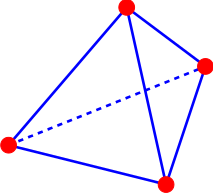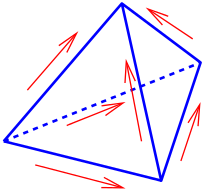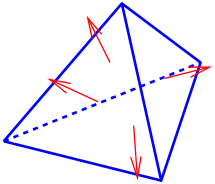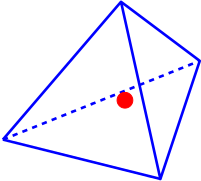$H(curl)$ and $H(div)$ function spaces¶
Scalar and vectorial elements in NGSolve:
Standard continuous $H^1$ elements:

Nedelec's tangentially-continuous $H(curl)$-conforming edge elements:

Raviart-Thomas normally-continuous $H(div)$-conforming face elements:

Discontinuous $L_2$ elements:

These vector-valued spaces allow to represent physical quantities which are either normally or tangentially continuous.
The finite element spaces are related by the de Rham complex:
$$ \DeclareMathOperator{\Grad}{grad} \DeclareMathOperator{\Curl}{curl} \DeclareMathOperator{\Div}{div} \begin{array}{ccccccc} H^1 & \stackrel{\Grad}{\longrightarrow} & H(\Curl) & \stackrel{\Curl}{\longrightarrow} & H(\Div) & \stackrel{\Div}{\longrightarrow} & L^2 \\[8pt] \bigcup & & \bigcup & & \bigcup & & \bigcup \\[8pt] W_{h} & \stackrel{\Grad}{\longrightarrow} & V_{h } & \stackrel{\Curl}{\longrightarrow} & Q_{h} & \stackrel{\Div}{\longrightarrow} & S_{h} \: \\[3ex] \end{array} $$NGSolve supports these elements of arbitrary order, on all common element shapes (trigs, quads, tets, prisms, pyramids, hexes). Elements may be curved.
import netgen.gui
%gui tk
from ngsolve import *
from netgen.geom2d import unit_square
from netgen.csg import unit_cube
mesh = Mesh(unit_square.GenerateMesh(maxh=0.3))
Generate a higher order $H^1$-space. We first explore its different types of basis functions.
order=3
fes = H1(mesh, order=order)
gfu = GridFunction(fes)
Draw(gfu)
The first #vertices basis functions are hat-functions. By setting the solution vector to a unit-vector, we may look at the individual basis functions:
SetVisualization(min=0, max=1)
gfu.vec[:] = 0
# vertex nr:
gfu.vec[17] = 1
Redraw()
The next are edge-bubbles, where we have $(order-1)$ basis functions per edge. A NodeId object refers to a particular vertex, edge, face or cell node in the mesh. We can ask for the degrees of freedom on a node:
# basis functions on edge nr:
edge_dofs = fes.GetDofNrs(NodeId(EDGE,10))
print("edge_dofs =", edge_dofs)
SetVisualization(min=-0.05, max=0.05)
gfu.vec[:] = 0
gfu.vec[edge_dofs[1]] = 1
Redraw()
Finally, we have $(p-1)(p-2)/2$ inner basis functions on every triangle:
trig_dofs = fes.GetDofNrs(NodeId(FACE,0))
print("trig_dofs = ", trig_dofs)
SetVisualization(min=0, max=0.03)
gfu.vec[:] = 0
gfu.vec[trig_dofs[0]] = 1
Redraw()
The FESpace also maintains information about local dofs, interface dofs and wire-basket dofs for the BDDC preconditioner:
for i in range(fes.ndof):
print (i,":", fes.CouplingType(i))
In NGSolve we use hierarchical high order finite element basis functions with node-wise exact sequences. The lowest order space $W_{l.o}$ is the edge-element space:
$$ \begin{array}{rcll} W_{hp} & = & W_{p=1} + \sum_E W_E + \sum_F W_F + \sum_C W_C & \subset H^1 \\[0.5em] V_{hp} & = & W_{l.o} + \sum_E V_E + \sum_F V_F + \sum_C V_C & \subset H(curl) \end{array} $$where the edge, face and cell blocks are compatible in the sense that
$$ \nabla W_E = V_E, \quad \nabla W_F \subset V_F, \quad \nabla W_C \subset V_C $$We obtain this by using gradients of $H^1$ basis functions as $H(curl)$ basis functions, and some more (see thesis Sabine Zaglmayr):
$$ \begin{array}{rcl} V_E & = & \text{span} \{ \nabla \varphi_{E,i}^{H^1} \} \\ V_F & = & \text{span} \{ \nabla \varphi_{F,i}^{H^1} \cup \widetilde \varphi_{F,i}^{H(curl)} \} \\ V_C & = & \text{span} \{ \nabla \varphi_{C,i}^{H^1} \cup \widetilde \varphi_{C,i}^{H(curl)} \} \end{array} $$fes = HCurl(mesh, order=2)
uc = GridFunction(fes, name="uc")
Draw (uc)
Draw (curl(uc), mesh, "curl")
edge_dofs = fes.GetDofNrs(NodeId(EDGE,10))
print ("edgedofs: ", edge_dofs)
uc.vec[:] = 0
uc.vec[edge_dofs[1]] = 1
Redraw()
look at them by activating Draw Surface Vectors.
face_dofs = fes.GetDofNrs(NodeId(FACE,10))
print ("facedofs: ", face_dofs)
uc.vec[:] = 0
uc.vec[face_dofs[1]] = 1
Redraw()